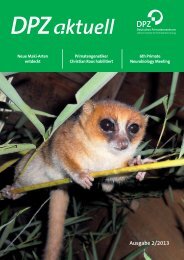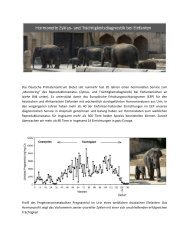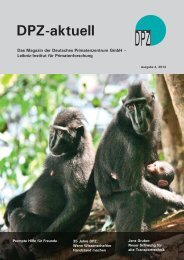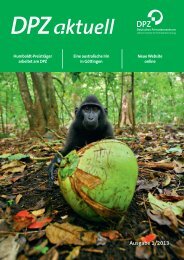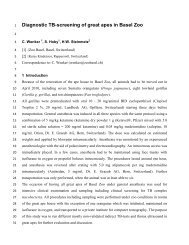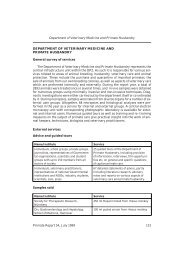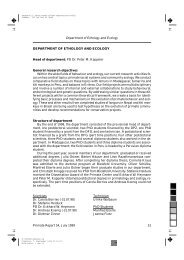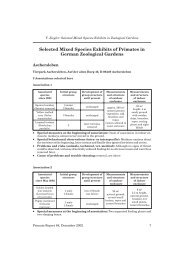Vol. 15 - Deutsches Primatenzentrum
Vol. 15 - Deutsches Primatenzentrum
Vol. 15 - Deutsches Primatenzentrum
Create successful ePaper yourself
Turn your PDF publications into a flip-book with our unique Google optimized e-Paper software.
Lemur News <strong>Vol</strong>. <strong>15</strong>, 2010 Page 21<br />
morning.During this time,175 feeding observations were recorded,and<br />
no fruit was consumed.During this second study,<br />
a focal animal was observed to be chased out of a feeding<br />
tree by a female E.coronatus.The female E.coronatus then began<br />
eating the unripe fruits of the tree.It thus seems that during<br />
times of fruit abundance L. ankaranensis utilize fruits as a<br />
food resource along with several other lemur species occurring<br />
in the area. However, when food resources were not<br />
abundant in the dry season, only leaves were eaten and<br />
interspecific competition appears to be higher.<br />
On several occasions during this second study, leaf stems<br />
were snapped from trees and white tree exudates were consumed.<br />
Latex exudates are thought to be a toxic defence<br />
mechanism and therefore usually avoided by primates (Glander,1994),but<br />
latex feeding by Colobus spp.has also been observed<br />
(Mckey, 1978). Other lemur species, such as Phaner<br />
furcifer (Petter et al., 1975;Petter,1978;Thalmann,2006) and<br />
Mirza coquereli (Hladik,1979),are also known to feed on tree<br />
exudates. A review of the literature on exudate feeding in<br />
primates by Coimbra-Filho and Mittermeier (1977) suggested<br />
that tree exudates, in addition to simple sugars, protein,<br />
and minerals,may also provide a source of calcium.However,<br />
the latter authors also suggested that for most primates<br />
exudate feeding was rare and of little nutritional importance.<br />
This short report highlighted some behaviors of Lepilemur<br />
ankaranensis,a relatively poorly studied member of the Lepilemur<br />
genus. Further field work is required to examine in detail<br />
the previously discussed observations and to improve<br />
our knowledge of this species.<br />
References<br />
Coimbra-Filho, A.F.; Mittermeier, R.A. 1977. Tree-gouging,<br />
exudate-eating and the "short-tusked" condition in Callithrix<br />
and Cebuella. Pp. 105-1<strong>15</strong>. In: D.G. Kleiman (ed.). The<br />
Biology and Conservation of the Callitrichidae. Smithsonian<br />
Institution Press, Washington, D. C.<br />
Ganzhorn,J.U.;Pietsch,T.;Fietz,J.;Gross,S.;Schmid,J;Steiner,<br />
N. 2004. Selection of food and ranging behavior in a sexually<br />
monomorphic folivorous lemur: Lepilemur ruficaudatus.<br />
Journal of Zoology 263: 393-399.<br />
Glander, K.E. 1994. Nonhuman primate self-medication with<br />
wild plant foods.Pp.239-256.In:N.L.Etkin (ed.).Eating on<br />
the wild side: The Pharmacologic, Ecologic, and Social Implications<br />
of Using Nncultigens. University of Arizona<br />
Press, Tuscon.<br />
Hladik, C.M. 1979. Diet and ecology of prosimians. Pp. 307-<br />
357. In: A. Doyle; R.D. Martin (eds.). The Study of Prosimian<br />
Behavior. Academic Press, New York and London.<br />
Mckey,D.1978.Plant Chemical Defences and the Ranging Behaviour<br />
of Colobus Monkeys in African Rainforests. Ph.D.<br />
thesis, University of Michigan, Ann Arbor.<br />
Mittermeier,R.A.;Ganzhorn,J.U.;Konstant,W.R.;Glander,K.;<br />
Tattersall, I.;Groves,C.P.;Rylands,A.B.;Hapke,A.;Ratsimbazafy,<br />
J.; Mayor, M.I.; Louis, E.E.; Rumpler, Y.; Schwitzer, C.;<br />
Rasoloarison, R.M. 2008. Lemur diversity in Madagascar.<br />
International Journal of Primatology 29: 1607-1656.<br />
Petter, J.J. 1978. Ecological and physiological adaptations of<br />
five sympatric nocturnal lemurs to seasonal variations in<br />
food production. Pp. 211-223. In: D.J. Chivers; J. Herbert<br />
(eds.). Recent Advances in Primatology, <strong>Vol</strong>. 1: Behavior.<br />
Academic Press, New York and London.<br />
Petter,J.J.;Schilling,A.;Pariente,G.1975.Observations on the<br />
behavior and ecology of Phaner furcifer. Pp. 209-218. In: I.<br />
Tattersall; R.W. Sussman (eds.). Lemur Biology. Plenum<br />
Press, New York.<br />
Ratsirarson, J.; Anderson, J.; Warter, S.; Rumpler, Y. 1987. Notes<br />
on the Distribution of Lepilemur septentrionalis and Lepilemur<br />
mustelinus in Northern Madagascar. Primates 28:<br />
119-122.<br />
Thalmann, U. 2001. Food resource characteristics in two<br />
nocturnal lemurs with different social behavior: Avahi<br />
occidentalis and Lepilemur edwardsi.International Journal of<br />
Primatology 22: 287-324.<br />
Thalmann, U.; Ganzhorn, J.U. 2003. The Sportive Lemurs, genus<br />
Lepilemur.In:S.M.Goodman;J.Benstead (eds.).Natural<br />
History of Madagascar. The University of Chicago Press,<br />
Chicago.<br />
Thalmann, U. 2006. Lemurs - Ambassadors for Madagascar.<br />
Madagascar Conservation and Development 1: 4-8.<br />
Hypotheses on ecological interactions<br />
between the aye-aye (Daubentonia madagascariensis)<br />
and microhylid frogs of the<br />
genus Platypelis in Tsaratanana bamboo<br />
forest<br />
Andolalao Rakotoarison 1*, Solohery A. Rasamison 1,<br />
Emile Rajeriarison 2,David R.Vieites 3,Miguel Vences 4<br />
1Département de Biologie Animale, Université d’Antananarivo,<br />
BP 906, Antananarivo 101, Madagascar<br />
2Research assistant, Ranomafana National Park, BP 2, Fivondronana,<br />
Ifanadiana, Ranomafana 312, Madagascar<br />
3Museo Nacional de Ciencias Naturales-CSIC, C/José Gutiérrez<br />
Abascal 2, 28006 Madrid, Spain<br />
4Zoological Institute, Technische Universität Braunschweig,<br />
Spielmannstr. 8, 38106 Braunschweig, Germany<br />
*Corresponding author: andomailaka@gmail.com<br />
The aye-aye (Daubentonia madagascariensis) is the most distinctive<br />
of all lemurs.It is the only known living species of the<br />
Daubentoniidae (Simon and Meyer, 2001). The hands of the<br />
aye-aye are highly specialised,with long and slender third fingers<br />
that are used for precise grooming, mainly at face level,<br />
to get food into the mouth with rapid movements,and to tap<br />
on the bark of tree trunks to detect insect larvae or other<br />
arthropods (Goix,1993).When an aye-aye locates a cavity,it<br />
will anchor the upper incisors into the wood and then gnaw<br />
away at the wood with the lower incisors to make a pit<br />
(Erickson, 1995a, 1994). This unique manner of foraging for<br />
arthropods leaves traces of biting on the wood cover which<br />
are often used to ascertain the presence of the species even<br />
without an actual sighting (Duckworth,1993 and own observations<br />
of one of us, ER). During a recent herpetological inventory<br />
on the Tsaratanana massif in northern Madagascar,<br />
we noticed bamboo holes that were possibly caused or enlarged<br />
by foraging aye-aye,and we observed frogs living inside<br />
these cavities. Here we report these observations and posit<br />
a number of hypotheses on the possible ecological interactions<br />
among these species, with the goal of stimulating further<br />
studies.<br />
During a herpetological inventory in Tsaratanana (the highest<br />
mountain massif of Madagascar,which rises up to 2876 m<br />
above sea level) one of us (AR) carried out an ecological<br />
study on frogs of the genus Platypelis (Mycrohylidae: Cophylinae),<br />
from the 9th to the 22nd of June 2010. Specifically, we<br />
worked in a mountain forest bordering the temporary pond<br />
locally called Matsabory Maiky (S 14°09’04.09"- E 48°57’<br />
26.06" – 2,066 m elevation) - corresponding to campsite 2 on<br />
the trail from Mangindrano to the Maromokotro peak. The<br />
observed Platypelis occupy a specific microhabitat: the species<br />
live and breed inside the bamboo internodes which contain<br />
water and are accessible through small external holes.<br />
These frogs have endotrophic development: their non-feeding<br />
tadpoles develop inside the water retained in the tree<br />
holes and bamboo internodes. Based on a comparison with<br />
type material and DNA barcoding, we ascertained that the<br />
encountered Platypelis belong to two species described from





